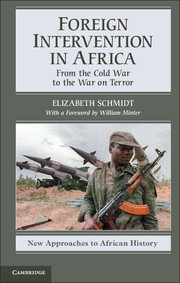Book contents
- Frontmatter
- Contents
- Illustrations
- Acknowledgments
- Foreword
- Abbreviations
- MAP 0.1. Africa, 1947. (Map by Philip Schwartzberg, Meridian Mapping, Minneapolis.)
- MAP 0.2. Africa, 2011. (Map by Philip Schwartzberg, Meridian Mapping, Minneapolis.)
- Introduction
- 1 Nationalism, Decolonization, and the Cold War, 1945–1991
- 2 Egypt and Algeria Radical Nationalism, Nonalignment, and External Intervention in North Africa, 1952–1973
- 3 The Congo Crisis, 1960–1965
- 4 War and Decolonization in Portugal's African Empire, 1961–1975
- 5 White-Minority Rule in Southern Africa, 1960–1990
- 6 Conflict in the Horn, 1952–1993
- 7 France's Private African Domain, 1947–1991
- 8 From the Cold War to the War on Terror, 1991–2010
- Conclusion
- Index
- References
6 - Conflict in the Horn, 1952–1993
Published online by Cambridge University Press: 05 February 2013
- Frontmatter
- Contents
- Illustrations
- Acknowledgments
- Foreword
- Abbreviations
- MAP 0.1. Africa, 1947. (Map by Philip Schwartzberg, Meridian Mapping, Minneapolis.)
- MAP 0.2. Africa, 2011. (Map by Philip Schwartzberg, Meridian Mapping, Minneapolis.)
- Introduction
- 1 Nationalism, Decolonization, and the Cold War, 1945–1991
- 2 Egypt and Algeria Radical Nationalism, Nonalignment, and External Intervention in North Africa, 1952–1973
- 3 The Congo Crisis, 1960–1965
- 4 War and Decolonization in Portugal's African Empire, 1961–1975
- 5 White-Minority Rule in Southern Africa, 1960–1990
- 6 Conflict in the Horn, 1952–1993
- 7 France's Private African Domain, 1947–1991
- 8 From the Cold War to the War on Terror, 1991–2010
- Conclusion
- Index
- References
Summary
Simultaneous with the struggle for Southern Africa was the Cold War battle for the Horn. Bordering on the critical Red Sea and Indian Ocean sea-lanes and in close proximity to Middle Eastern oil, Ethiopia and Somalia were both regional rivals and objects of competition between the United States and the Soviet Union. While the dynamics of decolonization established the framework for Cold War battles in North Africa, the Congo, the Portuguese colonies, and the white-ruled regimes of Southern Africa, superpower involvement in the Horn of Africa was primarily linked to postcolonial regional competition. Like African actors elsewhere on the continent, contenders for power in the Horn sought support from Cold War antagonists in order to promote their own national and regional endeavors. Although the effects of American and Soviet intervention were at times decisive, Washington and Moscow responded to African internal dynamics; they did not cause them.
African-superpower alliances in the Horn were complex and fluid. In the early 1970s, the United States helped sustain Emperor Haile Selassie's feudal order in Ethiopia while the nominally socialist military regime of Mohamed Siad Barre in Somalia was supported by the Soviet Union. However, by 1978, after a military coup in Ethiopia had brought a self-proclaimed Marxist regime to power and Somalia had attempted to annex Somali-inhabited territory in Ethiopia, Moscow and Washington had switched sides. Each had done so with reluctance, having initially hoped to maintain relations with both countries. Meanwhile, the collapse of Haile Selassie's regime had resulted in a surge of separatist movements among peoples subjugated by the Ethiopian empire. Most significantly, the nationalist movement in the former Italian colony of Eritrea, which had been annexed by Ethiopia in 1962, escalated its war for independence. Although the Soviet Union had long promoted the Eritrean cause, it withdrew its support after shifting its allegiance from Somalia to Ethiopia. Cuba, in contrast, supported Ethiopia in many capacities but refused to support its war against Eritrea.
- Type
- Chapter
- Information
- Foreign Intervention in AfricaFrom the Cold War to the War on Terror, pp. 142 - 163Publisher: Cambridge University PressPrint publication year: 2013

